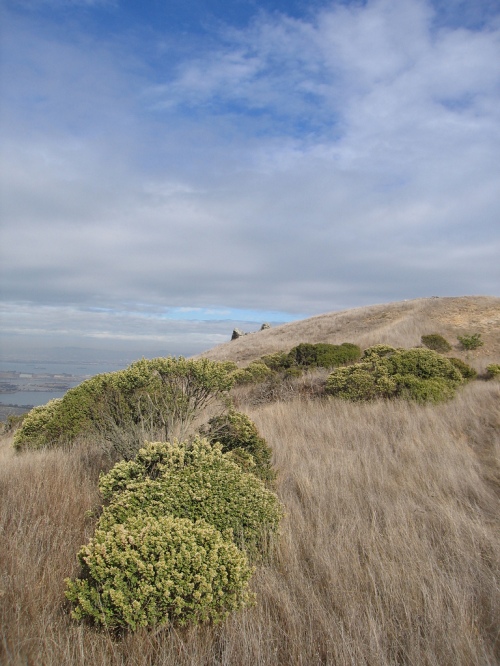
A number of years ago, Dave Schooley of San Bruno Mountain Watch, was ready to give up the fight, move on, find some other pastures. He did some travelling, and ended up at San Bruno mountain in Italy. There he ran into a local who been born in Half Moon Bay and knew both mountains. The one in Italy had a monestary on it, one that had devoted itself to nature, and had nurtured their mountain. It renewed Dave’s desire to carry on the fight back here in California.
He has been working to protect San Bruno mountain for 45 years, and there are still threats chipping away at what is left of the San Bruno’s natural state. Dave gave us a tour of the mountain, its canyons, dense scrub, oak woodlands, its foxes, coyotes, and mountain lions, its wild flowers, and birds, and its long history. There have been humans around and on the mountain for thousands of years, as evidenced by any number of shell mounds.
The mountain might have been developed much earlier, without much of a fight however, if it had not been for garbage. As the areas around train tracks between Brisbane and Candlestick became a dumping ground for San Francisco, there wasn’t much interest in living next to the smells of rotting garbage.
Real threats came back to the mountain when the Bay Area as a whole began to wake up to the state of the environment and the bay itself. With the area cleaned up, great hopes began to arise about what could be done. There was even plans to shave the top of the mountain off and make high rises. Most of the mountain at the time was owned by the Crocker Family. While there is land preserved as park, land donated to and donated by the county, there is still plenty of private land that might be developed.
Much of the fight has centered around endangered species like the Mission blue butterfly. The butterfly’s endangered status saved the mountain from further development. That and the efforts of people like Dave Schooley, and all those who came out to fight and protest development plans. The big dividing line in mountain activists has been around endangered species on private land. A loophole to the ESA, called Habitat Conservation Plans were invented at this time. It allows landowners to develop their land, provided they can recreate that habitat elsewhere. In practice this has not worked out. It’s lack of accountability, and test-ability aside, the practice of using HCPs has now spread nation wide.
The problems and challenges aside, Dave, still seems to have great hopes for the mountains and the wider region… proposing wild life corridors between the mountain and Lake Merced, McClaren, and lands to the south.
More information:
Read Full Post »


